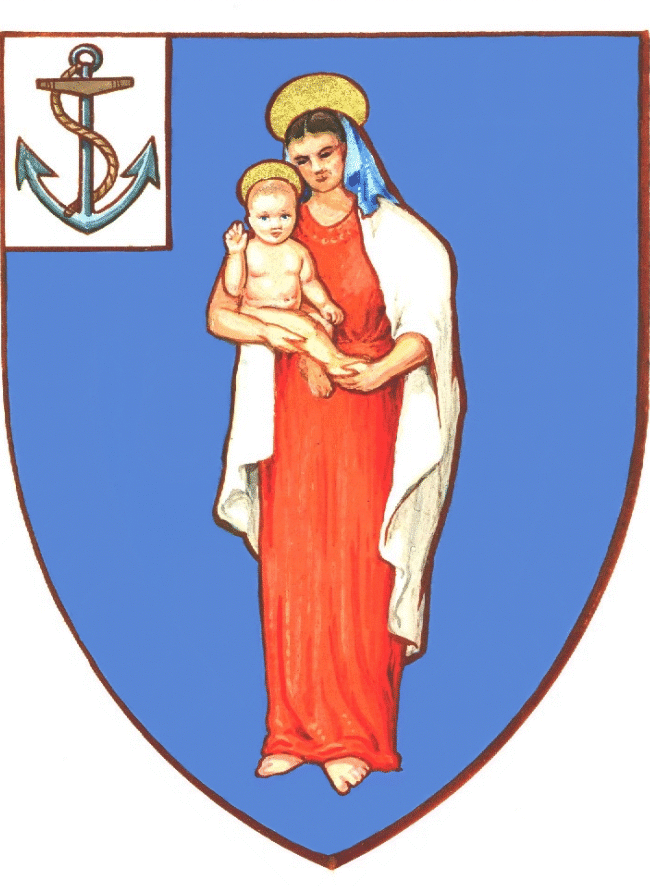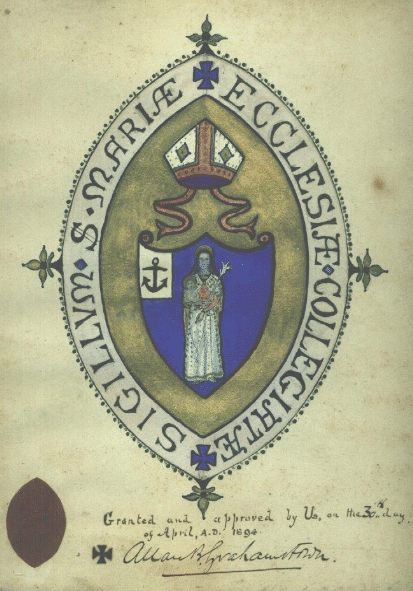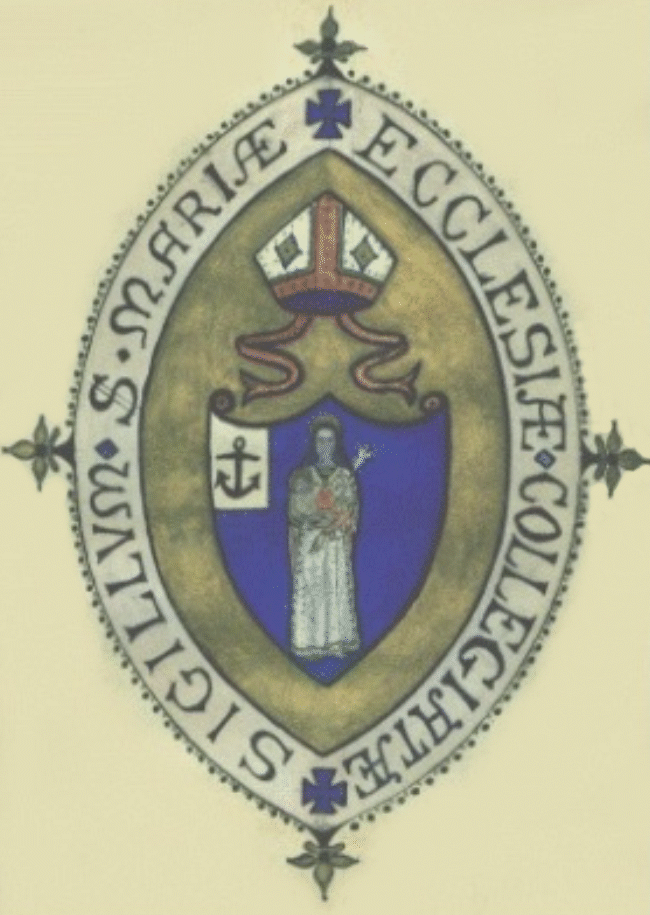

Cathedral of St MARY the VIRGIN, Port Elizabeth
Diocese: Port Elizabeth (until 1970, Grahamstown)

Arms originally granted in 1894 by Allan Becher Webb, fourth Bishop of Grahamstown, to the Collegiate Church of St Mary the Virgin, and granted by the College of Arms on 24 August 1952. They are blazoned:
Arms: Azure a representation of the Virgin Mary and the Holy Infant proper on a Canton Argent an Anchor proper.
About the arms:
In typical blazon as used by the College of Arms at the time, there is no punctuation, and all the colour names and principal charges are spelt with capital letters.
The principal charge is naturally Mary holding the Infant Christ. Both have haloes, and the naked boy baby is shown with His right hand raised in benediction.
Blue is traditionally a colour associated with the Virgin. In this drawing it is shown fairly pale; azure is not a particular shade, but can be any shade of blue except where it is contrasted with bleu céleste, which is always pale blue.
The anchor in the arms probably has a dual symbolism. It represents Jesus Christ as our Saviour, but also is a borrowing from the arms of the Diocese of Grahamstown.
The anchor of heraldry is always (unless otherwise stated) a fouled stock anchor – with a rope twisted around the shank – and is depicted two-dimensionally. In reality the stock (the top crossmember) is at right angles to the arm (at the base, carrying the flukes). The stock is always wooden, whereas stock anchors actually used during the 20th century usually had metal stocks.
Original grant:

 Bishop Webb granted the collegiate church a coat of arms and seal on 3 April 1894. The seal is in the form of a vesica – a double-pointed oval, well suited to ecclesiastical arms as they can comfortably contain a shield in the lower half and a mitre in the upper.
Bishop Webb granted the collegiate church a coat of arms and seal on 3 April 1894. The seal is in the form of a vesica – a double-pointed oval, well suited to ecclesiastical arms as they can comfortably contain a shield in the lower half and a mitre in the upper.
The original of this document was lost when the church building was destroyed by fire in 1895, and a duplicate deed of grant was made the following year by Bishop Webb and signed on 4 March 1896.
In heraldic terms the contents of this shield are much as blazoned in the 1952 grant, but the detail of the Virgin is hard to make out. She is crowned, but the style of crown is unclear. She appears to hold the Christ Child in her left arm, and to be holding a lily (another traditional symbol of the Virgin), but all this detail is unclear.
About the parish:
St Mary’s, the first Anglican church erected in what came to be called the Eastern Province of the Cape Colony, was founded in 1825 by the Rev Francis McCleland, an Irish 1820 Settler who in that year was appointed Colonial Chaplain to the settlement of some 500 people.
The Irish settlers had initially been sent to live at Clanwilliam, some 200 km north of Cape Town, on the grounds that the volatile Irish were likely to clash violently with the other settlers. However, they had felt isolated in that environment and requested permission to join the English, Welsh and Scottish settlers in the Eastern Cape.
The foundation stone of the first church building was laid in ’25, but the structure was not opened for worship until 1832. In the interim the congregation met in a schoolroom near the present St Augustine’s Roman Catholic Cathedral in Prospect Hill.
With the assistance of St Andrew’s College in Grahamstown, St Mary’s Vestry pioneered the Diocesan Grammar School in Port Elizabeth in 1856. This was, however, not an enduring venture; it ran into financial difficulties, and before it could be re-established the Governor, Sir George Grey, had endowed his own school (the Grey Institute) in Port Elizabeth.
The first organ was installed in 1867, by which time there was a well-established choir. St Mary’s continues its choral tradition to this day, being host to the only boys’ and men’s choir in the English cathedral tradition in South Africa.
In 1888 St Mary’s was constituted a collegiate church by Bishop Webb. In terms of its constitution, the Bishop of Grahamstown was to be its Provost, and the rector (at the time Canon A T Wirgman) its Vice-Provost.
An interesting anomaly (now eliminated) is that when the Diocese of Port Elizabeth was created in 1970, the constitution of St Mary’s was not altered, so although the Bishop of Port Elizabeth was from that time on effectively Provost, the constitution still referred to the Bishop of Grahamstown.
Following the fire of 1895, which completely destroyed the building, a new structure was quickly erected in far grander style, thanks in part to donations collected from people as diverse as the then Prime Minister of the Cape Colony, Cecil John Rhodes, and President Paul Kruger of the Zuid Afrikaansche Republiek.
In Mr McCleland’s time, St Mary’s was the only Anglican church in Port Elizabeth. But when Mr Wirgman took over and introduced a High Church form of worship, a number of parishioners, inclined to a more Evangelical style, withdrew in 1854 and formed their own congregation, eventually called Holy Trinity. This congregation initially worshipped at the bottom of Military Road, but at the urging of the bishop of the day, erected a building on Port Elizabeth’s Central Hill, well above but only a few blocks west of St Mary’s.
In part thanks to the long ministry of Mr Wirgman – half a century – St Mary’s has remained faithful to the High Church style of worship.
Following the liturgical reforms of the 1970s and ’80s, when the order of service was substantially altered and modern English established as the language of worship, most Anglican congregations in South Africa have abandoned the Book of Common Prayer of 1662, which for centuries has defined Anglican worship. St Mary’s, however, has remained faithful to the old Prayer Book.
Following the establishment of the Diocese of Port Elizabeth in 1970, the first three bishops of the diocese felt that it was inadvisable to establish a cathedral, for reasons relating to the ethnic composition of the city and the diocese.
However the fourth bishop, Bethlehem Nopece, who took office in 2001, felt that there was a need for a cathedral and that St Mary’s was ideal for the purpose.
At his instance, the diocese also created, at its synod in July 2003, the office of Dean, the holder of which would not necessarily be the rector of the cathedral parish. Since the first Dean is not the rector, the incumbent rector has been elevated to Provost.
St Mary’s church building was formally consecrated a cathedral on 2 November 2003.
More information about the church can be found here.

Back to Armoria ecclesiastica index
Comments, queries: Mike Oettle